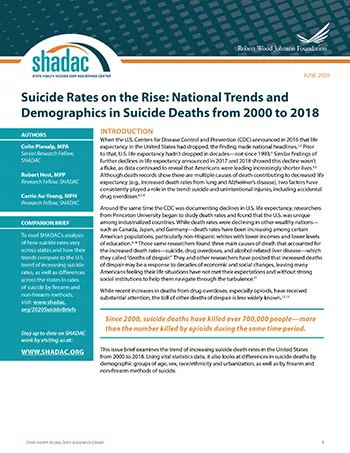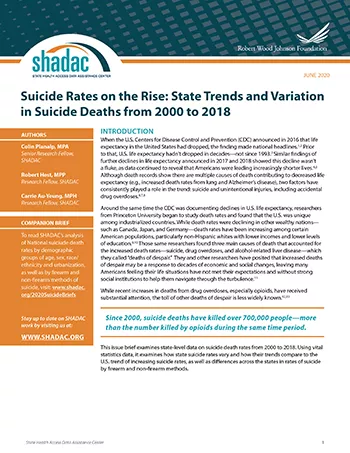Among the numerous impacts resulting from the arrival of the coronavirus pandemic, early evidence from several recent national polls suggests that the COVID-19 crisis is taking a significant toll on mental health in the United States.1 While we will not be able to fully comprehend the extent of this toll until data on one important indicator of mental health, rates of suicide deaths, is released for the current period, examining estimates from 2018 (the most recent data year available) provides an important baseline from which to begin understanding potential shifts in the landscape of mental health and “deaths of despair” such as suicide as a result of COVID-19.
Death rates from suicide in the United States have been increasing at an alarming pace, rising from 10.4 to 14.2 per 100,000 people from 2000 to 2018 (an increase of 37 percent). This increase represents about 110,000 additional lives lost than if the U.S. suicide rate had remained steady. Suicide has killed over 700,000 people since 2000—more than the number killed by another, more well-known national epidemic, opioids, during the same time period
Suicide deaths have not only increased significantly over the past nearly two decades, but their growth is continuing a pattern of acceleration in more recent years: From 2000 to 2009 the suicide death rate grew by 13 percent, but from 2009 to 2018 the rate grew by 21 percent.
As part of an analysis aiming to shed more light on this growing public health concern, SHADAC researchers have produced two issue briefs that provide high-level information regarding trends in suicide deaths from 2000 to 2018. Each brief presents historical context for the troubling recent acceleration in the rise of suicide rates and mortality in the United States, and examines trends in suicide-related mortality across the nation and states, and among specific population subgroups. Click on the briefs below to download.
Sources
Data on Suicide Deaths are available from SHADAC’s State Health Compare tool and were recently updated to include estimates from 2018, the latest data year available. This measure can be viewed by demographics including age, gender, race/ethnicity, metropolitan status, and cause of death. Estimates on State Health Compare come from the Centers for Disease Control and Prevention (CDC), National Center for Health Statistics via the CDC WONDER Database.
National Suicide Prevention Lifeline: 1-800-273-8255
If you’re thinking about suicide, are worried about a friend or loved one, or would like emotional support, the Lifeline network is available 24/7 across the United States. For more suicide prevention resources, visit https://suicidepreventionlifeline.org/
1 Kirzinger, A., Hamel, L., Muñana C., Kearney, A., & Brodie, M. (2020, April 24). KFF Health Tracking Poll – Late April 2020: Coronavirus, Social Distancing, and Contact Tracing. Retrieved from https://www.kff.org/report-section/kff-health-tracking-poll-late-april-2020-economic-and-mental-health-impacts-of-coronavirus/
Planalp, C., Alarcon, G., & Blewett, L. (2020, May 26). 90 percent of U.S. adults report increased stress due to pandemic. Retrieved from https://shadac.org/SHADAC_COVID19_Stress_AmeriSpeak-Survey


